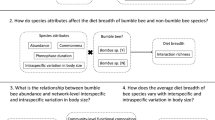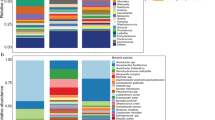Abstract
The rapidly increasing body of literature on commensal microbiota has revealed a large phylotypic and functional diversity of microbes associated with vertebrates and invertebrates. In insects, the gut microbiota plays a role in digestion and metabolism of the host as well as protects the host against pathogens. In the study reported here, we sampled gut microbiota of the larvae of the Glanville fritillary butterfly (Melitaea cinxia). The larvae were collected from the field or reared in the laboratory. This butterfly has two host plant species, Plantago lanceolata and Veronica spicata, and the host plant species is known from previous studies to influence larval growth rate. However, our results demonstrate that about 50 % of the variation in larval growth rate can be attributed to the effect of the gut microbial composition plus the joint effect of microbiota and the host plant species, while host plant species alone makes no significant contribution. Our results support previous studies showing that diet influences the gut microbiota but, more unexpectedly, that the composition of the gut microbiota significantly influences larval growth rate. We suggest that host plant effects on larval growth and development observed in many previous studies may be mediated via the gut microbiota. While we measured the growth rate only in laboratory-reared larvae, the similarity of the gut microbial composition between samples from field-collected and laboratory-reared larvae suggests that the results can be generalized to natural conditions.



Similar content being viewed by others
References
Ahola V, Lehtonen R, Somervuo P et al (2014) The Glanville fritillary genome retains an ancient karyotype and reveals selective chromosomal fusions in Lepidoptera. Nat Commun 5:4737 doi: 10.1038/ncomms5737
Anders S, Huber W (2010) Differential expression analysis for sequence count data. Genome Biol 11:R106. doi:10.1186/gb-2010-11-10-r106
Awmack CS, Leather SR (2002) Host plant quality and fecundity in herbivorous insects. Annu Rev Entomol 47:817–844. doi:10.1146/annurev.ento.47.091201.145300
Bernays EA, Bright KL, Gonzalez N, Angel J (1994) Dietary mixing in a generalist herbivore: tests of two hypotheses. Ecology 75:1997–2006. doi:10.2307/1941604
Borcard D, Gillet F, Legendre P (2011) Numerical ecology with R. Springer SBM, Berlin
Broderick NA, Lemaitre B (2012) Gut-associated microbes of Drosophila melanogaster. Gut Microbes 3:307–321. doi:10.4161/gmic.19896
Broderick NA, Raffa KF, Goodman RM, Handelsman J (2004) Census of the bacterial community of the gypsy moth larval midgut by using culturing and culture-independent methods. Appl Environ Microbiol 70:293–300
Brune A, Ohkuma M (2011) Role of the termite gut microbiota in symbiotic digestion. In: Bignell DW, Roisin Y, Lo N (eds) Biology of termites: a modern synthesis. Springer SBM, Berlin, pp 439–475
Calderón-Cortés N, Quesada M, Watanabe H et al (2012) Endogenous plant cell wall digestion: a key mechanism in insect evolution. Annu Rev Ecol Evol Syst 43:45–71
Chandler JA, Lang JM, Bhatnagar S et al (2011) Bacterial communities of diverse Drosophila species: ecological context of a host–microbe model system. PLoS Genet 7:e1002272
Coley PD, Bateman ML, Kursar TA (2006) The effects of plant quality on caterpillar growth and defense against natural enemies. Oikos 115:219–228. doi:10.1111/j.2006.0030-1299.14928.x
Coon KL, Vogel KJ, Brown MR, Strand MR (2014) Mosquitoes rely on their gut microbiota for development. Mol Ecol 23:2727–2739. doi:10.1111/mec.12771
Dietrich C, Köhler T, Brune A (2014) The cockroach origin of the termite gut microbiota: patterns in bacterial community structure reflect major evolutionary events. Appl Environ Microbiol 80:2261–2269
Dillon RJ, Dillon VM (2004) The gut bacteria of insects: nonpathogenic interactions. Annu Rev Entomol 49:71–92
Douglas AE (2015) Multiorganismal insects: diversity and function of resident microorganisms. Annu Rev Entomol 60:17–34. doi:10.1146/annurev-ento-010814-020822
Edgar RC (2013) UPARSE: highly accurate OTU sequences from microbial amplicon reads. Nat Methods 10:996–998
Edwards U, Rogall T, Blöcker H et al (1989) Isolation and direct complete nucleotide determination of entire genes. Characterization of a gene coding for 16S ribosomal RNA. Nucleic Acids Res 17:7843–7853
Engel P, Moran NA (2013) The gut microbiota of insects—diversity in structure and function. FEMS Microbiol Rev 37:699–735
Haegeman B, Hamelin J, Moriarty J et al (2013) Robust estimation of microbial diversity in theory and in practice. ISME J 7:1092–1101. doi:10.1038/ismej.2013.10
Hammer TJ, Bowers MD (2015) Gut microbes may facilitate insect herbivory of chemically defended plants. Oecologia 79(1):1–14. doi: 10.1007/s00442-015-3327-1
Hammer TJ, McMillan WO, Fierer N (2014) Metamorphosis of a butterfly-associated bacterial community. PLoS One 9:e86995
Hanski IA (2011) Eco-evolutionary spatial dynamics in the Glanville fritillary butterfly. Proc Natl Acad Sci USA 108:14397–14404
Hanski I, Saastamoinen M, Ovaskainen O (2006) Dispersal-related life-history trade-offs in a butterfly metapopulation. J Anim Ecol 75:91–100
Ho C, Pennings SC, Carefoot TH et al (2010) Is diet quality an overlooked mechanism for Bergmann’s rule? Am Nat 175:269–276. doi:10.1086/649583
Jong MA, Wong SC, Lehtonen R, Hanski I (2014) Cytochrome P450 gene CYP337 and heritability of fitness traits in the Glanville fritillary butterfly. Mol Ecol 23:1994–2005
Klemme I, Hanski I (2009) Heritability of and strong single gene (Pgi) effects on life-history traits in the Glanville fritillary butterfly. J Evol Biol 22:1944–1953
Kohl KD, Dearing MD (2012) Experience matters: prior exposure to plant toxins enhances diversity of gut microbes in herbivores. Ecol Lett 15:1008–1015. doi:10.1111/j.1461-0248.2012.01822.x
Koskinen K, Hultman J, Paulin L et al (2011) Spatially differing bacterial communities in water columns of the northern Baltic Sea. FEMS Microbiol Ecol 75:99–110
Kuussaari M, van Nouhuys S, Hellman J, Singer MC (2004) Larval biology of checkerspots. In: Ehrlich PR, Hanski I (eds) On the wings of checkerspots: a model system for population biology. Oxford University Press, Oxford, pp 138–160
Kvist J, Wheat CW, Kallioniemi E et al (2013) Temperature treatments during larval development reveal extensive heritable and plastic variation in gene expression and life history traits. Mol Ecol 22:602–619
Lane DJ (1991) 16S/23S rRNA sequencing, nucleic acids in bacterial systematics. Wiley, New York
Lee YK, Mazmanian SK (2010) Has the microbiota played a critical role in the evolution of the adaptive immune system? Science 330:1768–1773
Legendre P, Legendre L (2012) Numerical ecology. Elsevier, Amsterdam
Ley RE, Lozupone CA, Hamady M et al (2008) Worlds within worlds: evolution of the vertebrate gut microbiota. Nat Rev Microbiol 6:776–788. doi:10.1038/nrmicro1978
Lozupone CA, Stombaugh JI, Gordon JI et al (2012) Diversity, stability and resilience of the human gut microbiota. Nature 489:220–230
Mason CJ, Raffa KF (2014) Acquisition and structuring of midgut bacterial communities in gypsy moth (Lepidoptera: Erebidae) larvae. Environ Entomol 43:595–604. doi:10.1603/EN14031
McMurdie PJ, Holmes S (2014) Waste not, want not: why rarefying microbiome data is inadmissible. PLoS Comput Biol 10:e1003531. doi:10.1371/journal.pcbi.1003531
Oh J, Byrd AL, Deming C et al (2014) Biogeography and individuality shape function in the human skin metagenome. Nature 514:59–64
Oksanen J, Blanchet G, Kindt R et al. (2015) vegan: Community ecology package. R package version 2.3-0. Available at: http://CRAN.R-project.org/package=vegan.
Ottman N, Smidt H, De Vos WM, Belzer C (2012) The function of our microbiota: who is out there and what do they do? Front Cell Infect Microbiol 2:104. doi: 10.3389/fcimb.2012.00104
Pernice M, Simpson SJ, Ponton F (2014) Towards an integrated understanding of gut microbiota using insects as model systems. J Insect Physiol 69:12–18
Ridley EV, Wong AC, Westmiller S, Douglas AE (2012) Impact of the resident microbiota on the nutritional phenotype of Drosophila melanogaster. PLoS One 7:e36765–e36765
Robinson CJ, Schloss P, Ramos Y et al (2010a) Robustness of the bacterial community in the cabbage white butterfly larval midgut. Microb Ecol 59:199–211
Robinson MD, McCarthy DJ, Smyth GK (2010b) edgeR: a bioconductor package for differential expression analysis of digital gene expression data. Bioinformatics 26:139–140. doi:10.1093/bioinformatics/btp616
Saastamoinen M (2008) Heritability of dispersal rate and other life history traits in the Glanville fritillary butterfly. Heredity 100:39–46
Saastamoinen M, van Nouhuys S, Nieminen M et al (2007) Development and survival of a specialist herbivore, Melitaea cinxia, on host plants producing high and low concentrations of iridoid glycosides. Ann Zool Fenn 44:70–80
Saastamoinen M, Ikonen S, Wong SC et al (2013) Plastic larval development in a butterfly has complex environmental and genetic causes and consequences for population dynamics. J Anim Ecol 82:529–539
Santo Domingo JW, Kaufman MG, Klug MJ et al (1998) Influence of diet on the structure and function of the bacterial hindgut community of crickets. Mol Ecol 7:761–767
Schmidt TS, Matias Rodrigues JF, Mering C (2014) Limits to robustness and reproducibility in the demarcation of operational taxonomic units. Environ Microbiol 17(5):1689–16706. doi: 10.1111/1462-2920.12610
Sharon G, Segal D, Ringo JM et al (2010) Commensal bacteria play a role in mating preference of Drosophila melanogaster. Proc Natl Acad Sci USA 107:20051–20056
Shin SC, Kim S-H, You H et al (2011) Drosophila microbiome modulates host developmental and metabolic homeostasis via insulin signaling. Science 334:670–674
Storelli G, Defaye A, Erkosar B et al (2011) Lactobacillus plantarum promotes Drosophila systemic growth by modulating hormonal signals through TOR-dependent nutrient sensing. Cell Metab 14:403–414
Stuart J (2015) Insect effectors and gene-for-gene interactions with host plants. Curr Opin Insect Sci 9:56–61. doi:10.1016/j.cois.2015.02.010
Sugio A, Dubreuil G, Giron D, Simon J-C (2014) Plant–insect interactions under bacterial influence: ecological implications and underlying mechanisms. J Exp Bot. doi:10.1093/jxb/eru435
Tang X, Freitak D, Vogel H et al (2012) Complexity and variability of gut commensal microbiota in polyphagous lepidopteran larvae. PLoS One 7:e36978
Tuomisto H (2010) A consistent terminology for quantifying species diversity? Yes, it does exist. Oecologia 164:853–860
Yun J-H, Roh SW, Whon TW et al (2014) Insect gut bacterial diversity determined by environmental habitat, diet, developmental stage, and phylogeny of host. Appl Environ Microbiol 80:5254–5264
Acknowledgments
We thank Emily Hornett, Guillaume Minard, Marjo Saastamoinen, and anonymous reviewers for comments on the manuscript.
Author contribution statement
IH designed the experiment; IS and MH collected the samples and performed the laboratory experiment; LR analyzed the sequence data and performed statistical analyses; LR and IH wrote the manuscript. All authors have approved the final version of the manuscript.
Author information
Authors and Affiliations
Corresponding author
Ethics declarations
Funding
This research was supported by the Academy of Finland (Grants 255350 and 250444 to IH and 13579 to LR).
Conflict of interest
The authors declare that they have no competing interests.
Statement of human and animal rights
This article does not contain any studies with human participants or animals (except invertebrates, which are except from ethical concerns) performed by any of the authors.
Additional information
Communicated by Corné Pieterse.
Electronic supplementary material
Below is the link to the electronic supplementary material.
Rights and permissions
About this article
Cite this article
Ruokolainen, L., Ikonen, S., Makkonen, H. et al. Larval growth rate is associated with the composition of the gut microbiota in the Glanville fritillary butterfly. Oecologia 181, 895–903 (2016). https://doi.org/10.1007/s00442-016-3603-8
Received:
Accepted:
Published:
Issue Date:
DOI: https://doi.org/10.1007/s00442-016-3603-8




